
Deer Antlers- Traditional Use and Future Perspectives
Publication Year: 2010
Author(s): Kawtikwar PS , Bhagwat DA , Sakarkar DM
Abstract:
Antlers are bony skeletal protuberances of the skull, and consist mainly of the protein collagen and the mineral calcium hydroxyapatite. Antlers occur in most species of the deer family (Cervidae) and are grown and shed annually, typically only by males. Traditional medical reports and clinical observations show that antler is biologically active to cure various diseases. To make antler products acceptable as nutraceuticals and functional foods, chemical and biological properties of velvet antlers have to be clearly determined. Antlers are made of chemical components consisting of sugars, fatty acids, amino acids, and nucleotides as essential molecules, which become macromolecules such as polysaccharides, lipids, proteins and nucleic acids, respectively. For their physicochemical properties, each of these macromolecules is responsible for not only antler growth and development, but also biomedical and nutraceuticals uses of antlers. Therefore, understanding chemical and molecular characteristics of antlers is crucially important to elucidate the clinical and medicinal efficacies of antlers.
Source of Publication: Indian Journal of Traditional Knowledge
Vol/Issue: 9(2) , 245-251pp.
Country: India
Publisher/Organisation: CSIR
URL:
https://nopr.niscpr.res.in/bitstream/123456789/8178/1/IJTK%209%282%29%20245-251.pdf
Theme: Traditional/ Indigenous Knowledge | Subtheme: Traditional Medicine
Related Documents
Books

Indigenous Medicine and Knowledge in African Society
Published Year: 2007
Abstract:
At the turn of the 20th century, African societies witnessed the suppression of indigenous hea... Read More
Research Papers/Articles
Abstract:
Evidence based Traditional complementary and alternative medicine (TCAM) in the management of... Read More




